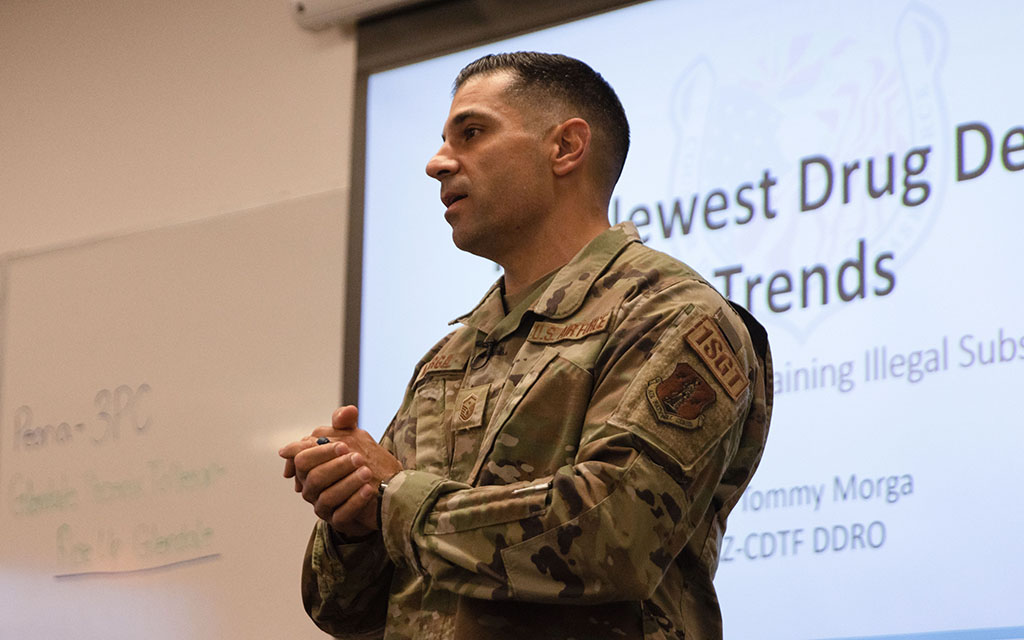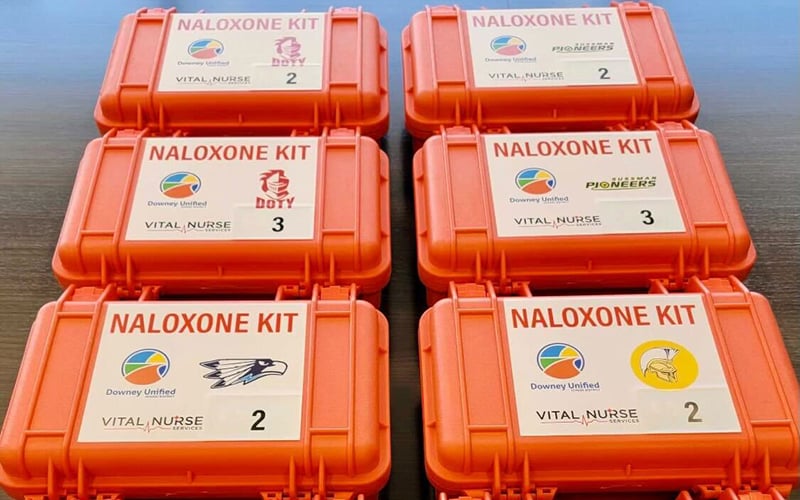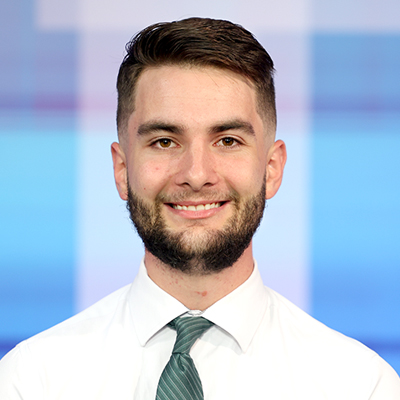GLENDALE – As a projection screen displays a collection of rainbow-colored pills, National Guard Sgt. Tommy Morga asks the dozens of parents, teenagers and educators gathered in a sprawling room: “Who here has heard about fentanyl?”
A few hands go up.
Morga, who’s part of the Arizona Counter Drug Task Force, tells the group that more kids today are getting fentanyl-laced opioids from anonymous dealers online, and it’s crucial for parents to understand what’s happening to prevent the problem from escalating.
“Only 17% of parents talk to their kids about (fentanyl overdoses),” Morga said in an interview with Cronkite News after the recent workshop. “There are ways to monitor the social media applications. The biggest thing is to have an open conversation with your kids.”

Parents look at Narcan being passed around during an opioid and social media education workshop in Glendale, on Sept. 28, 2022. Some 27 states allow public schools to carry Narcan, a medicine that can rapidly reverse an opioid overdose. (Photo by Laura Bargfeld/Cronkite News)
Opioid use – particularly the use of powerful synthetic opioids like fentanyl – remains a pressing problem. Overdose deaths rose during the COVID-19 pandemic, and in 2021, more than 100,000 people in the U.S. died of drug overdoses; about 71,000 of those deaths were related to synthetic opioids, according to data from the Centers for Disease Control and Prevention.
Already this year, Arizona health officials have recorded 1,267 overdose deaths involving synthetic opioids. In 2021, the state saw 2,779 total overdose deaths, the CDC reports, with 1,791 related to synthetic opioids like fentanyl – a drug 50 to 100 times more potent than morphine and typically used to treat advanced cancer pain.
Combating the rise in fentanyl use has been a top priority of the U.S. Drug Enforcement Administration, especially as drug traffickers turn to new tactics – such as manufacturing “rainbow fentanyl” pills in bright colors that may appeal to children.
“Those pills are pretty and they look like other things, like candy,” said Cheri Oz, special agent in charge of the DEA’s Phoenix Field Division. “They’re being marketed to a younger audience of potential customers.”
Cartels also are making pills that look like OxyContin, Percocet, Vicodin, Xanax and Adderall that are laced with fentanyl, and DEA lab testing has found that 4 out of every 10 pills containing fentanyl have at least 2 milligrams, which is considered a deadly dose.
“Fentanyl is a powder. It can be put into anything, it can look like anything,” Oz said. “If you think you’re taking an Adderall and you didn’t get it from your pharmacy, chances are it’s laced with fentanyl.”

National Guard Sgt. Tommy Morga educates parents about how drugs like fentanyl are sold through social media apps such as Snapchat. Although drug dealers operate through many social media platforms, experts are most worried about Snapchat due to the app’s anonymity, disappearing messages and lack of third-party monitoring. (Photo by Laura Bargfeld/Cronkite News)
Morga is part of an Arizona effort to help inform parents of the dangers of fentanyl and cartels’ use of social media to reach vulnerable youth. He collaborates with drug prevention groups, such as Rise Up! Glendale and the Peoria Primary Prevention Coalition, to conduct workshops to educate the public about the intersection of illicit drugs and social platforms.
Although drug dealers operate on many social media platforms, experts are most worried about Snapchat due to the app’s anonymity, disappearing messages and lack of third-party monitoring.
Morga’s training session included statistics about opioid overdoses along with what certain Snapchat symbols, emojis and hashtags might mean in connection with drug sales. He estimated that about 35% of Arizona youth are active on the platform.
“(Dealers) obviously know it’s the one that’s being used the most, so why not use the one they know can get the most contact with our kids?” Morga said, adding that the first step is for parents to better understand the situation so that they’re able to talk with their children.
“TalkNowAZ.com has a lot of really good resources on ways to talk to your kids and resources on some of these illicit drugs. Parents can actually get educated themselves, in order to trust themselves to talk to their kids about it.”

Parents take a quiz testing their knowledge of social media and opioids at the beginning of a workshop from the National Guard’s Arizona Counter Drug Task Force. (Photo by Laura Bargfeld/Cronkite News)
Denise Carlson of Peoria, who attended Morga’s workshop with her husband, said they planned to follow up with their teenage daughters to add additional parameters around social media use.
“We have two girls, so the next steps are talking to them about a little more structure with how they’re using their phones and social media and more talks about drugs,” she said. “We let our kids use Snapchat at an early age, and we really didn’t know enough about it. But now we’re going to be backtracking on what we’re going to let them do.”
Carlson said educational events like this are the best way for parents to learn about drug use among kids – and fentanyl, specifically.
“There are parents, like me, who probably don’t know enough about fentanyl,” she said. “Get involved with these types of groups and chats so you can learn about what’s going on in society and in our schools.”
State governments have taken steps to mitigate the fentanyl problem in schools.
According to a 2020 report by the Legislative Analysis and Public Policy Association, 27 states allow schools to stock naloxone, a medicine that can rapidly reverse an opioid overdose. In Arizona and six other states, school districts are required to have policies that detail how it should be administered. Pharmacists in Arizona can provide naloxone to anybody without a written prescription.
School districts have worked to address the issue, as well. For example, the Los Angeles Unified School District announced in September that it will make Narcan, one of the brand names for naloxone, available in all of its schools.
Oz said she hopes that as people become more educated, communities will take action to spread awareness about the dangers of fentanyl.
“As a parent and as a special agent, I hear these stories from my friends and co-workers whose lives are touched in very tragic ways by opioids,” she said. “When we’re talking about fentanyl, there’s no second chance. It’s one pill, one time.
“When you talk to (a) parent … that walked in the morning to wake up their child for school, and their child was unresponsive, that will break your heart. Talk to your kids, talk to your neighbors, talk to people at the grocery store – make this something that we are talking about, so that we are armed with the knowledge to make good choices and stay alive.”




